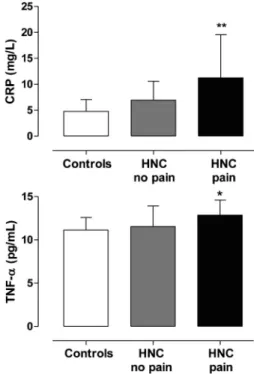Relationship of inflammatory markers and pain in patients with head and neck cancer prior to anticancer therapy
Texto
Imagem


Documentos relacionados
of periodontal infection progression, thanks to periodontal treatment, would decrease the levels of inflammatory markers such as IL-6, TNF- ␣ and C-reactive protein, which are common
regarding the topics of an association between periodontal disease and high levels of C-reactive protein and the use of periodontal therapy for reducing the levels of this
Objectives: To evaluate the association between the genetic polymorphism of the tumor necrosis factor-alpha (TNF- α ) gene and the development of sepsis and septic shock in
The aim of this study is to evaluate the coenzyme Q10 and selected pro-inflammatory markers such as interleukin 6 and tumor necrosis factor ␣ in children with Down syndrome..
According to Casaburi et al.. The relationship between chronic hypoxemia and activation of the tumor necrosis factor-alpha sys- tem in patients with chronic obstructive pulmonary
Because of the high correlations of superoxide dismutase 2 with pleural effusion interferon gamma and tumor necrosis factor alpha levels, this marker may act as an inflammatory
Objective: To explore the association between inflammatory markers such as high-sensitivity C-reactive protein (hs- CRP) and white blood cell (WBC) count and
In this prospective study, C-reactive protein (CRP), fi brinogen, factor VIIIc, interleukin-6 (IL-6), and tumor necrosis factor- α (TNF- α ) levels were measured on admission,